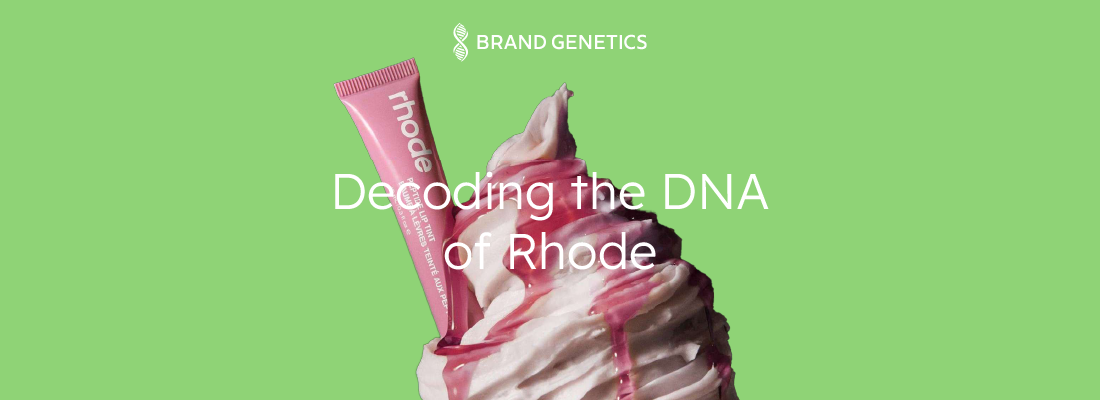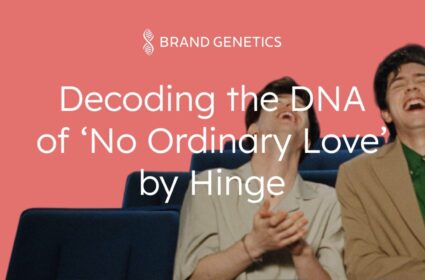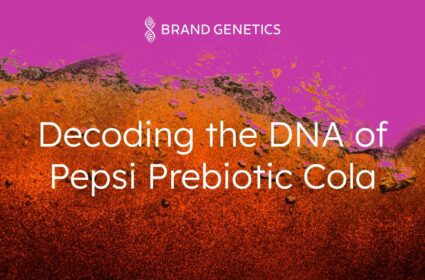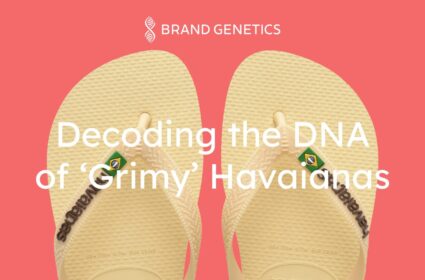Decoding the DNA of Rhode: How Hailey Bieber used sensorial marketing to glaze a million-dollar brand

This article is part of our series on DNA of Campaigns. You can view the full series or download the report.
At Brand Genetics, we know that the best brands don’t just sell products, they sell experiences. Following our deep dives into Starbuck’s code-switching success and Duolingo’s viral mischief, we’re now turning our lenses on Hailey Bieber’s skincare brand, Rhode. With playful sensorial marketing, Rhode has whipped up a storm in the beauty industry and beyond. In this piece, Rafaella Dhelomme, consultant at Brand Genetics, explores the DNA of Rhode’s branding success so far.
From glazed donut skin to ‘strawberry’ girl aesthetics, Rhode stands out with emotional branding, food code storytelling, and sensorial seduction, in a skincare market ruled by science-backed claims and lab coats. It’s no surprise that E.L.F purchased the brand last month in a deal worth US$1 billion.
Rhode’s sweet spot
In the past few years, celebrities have been launching skincare brands left-right-and-centre. But what made Rhode such a success? The answer is sensorial marketing: they have leveraged food to relay to customers the feelings, experience, and association of the products – bringing skincare out of the lab and onto the menu. They ‘anchored’ the products to items we consume on a regular basis, such as a croissant, a latte, or a bowl of ice cream, to create associations. By adopting the visual language, emotional associations and sensory cues of desserts and sweets, Rhode has made skincare feel indulgent, comforting and craveable.
They have crafted a brand experience that is emotionally seductive and visually delicious. They have product names like ‘Glazing Milk’ and ‘Vanilla Cake Tint’, evoking emotions of comfort, softness, sweetness, and self-care. The brand cues are from café culture – from pastel-hued packaging to food campaign imagery. The whipped consistencies of their products make them feel soothing, aspirational, and craveable. Their marketing further reinforces this edible aesthetic: lip treatments nestled beside pancakes, pink glazed tubes echoing frosted donuts, and milky droplets splashed across minimal backgrounds, suggesting nourishment.
This approach is especially relevant during a time of economic downturn as consumers tighten their purse strings for large purchases but put less effort into rationalising smaller buys like sweets or confectionery. By anchoring the products as ‘a little treat’, Rhode has tapped into and influenced the human subconscious. They have convinced consumers that splurging on their product is as manageable as consuming actual sweet treats, despite the considerable price difference. As evidence of their success, the business reported US$212 million in sales for 2024 – with no affiliation to any beauty retailers.

The perfect ingredients for Rhode’s viral success
So, what is going on and how does this sensorial approach work? As experts in consumer branding, let’s decode Rhode’s successful strategy.
-
Tangibility: Feeling through the feed
Rhode is an online-only brand that delivers D2C to a global customer base. It’s clear the challenge of being exclusively online lies in the absence of a tangible experience, leaving consumers wondering how the products would look and feel on them – an essential step to purchasing. Rhode tackles this with sensorial marketing – artfully using associations with familiar foods to bridge this gap.
Rhode builds hype with limited-run IRL pop-ups. From the minute you arrive at a Rhode pop-up, you enter an all-enveloping experience that fans are willing to queue for – for hours. Offering ice creams, photobooths, and sneak peaks to future launches, the pop-ups are sensorial events in themselves.
-
Wellness: ‘A little treat’ mindset
As a category, beauty has always been an outlet for self-care, providing small, daily joys. In recent years of instability, this has become an active hobby for many who are looking for ways of treating and pampering themselves affordably, within their existing lifestyles.
Rhode’s honey-sweet sensorial campaigns don’t just provide cut-through from the plethora of science-backed skincare brands; they resonate particularly well with audiences during these times of economic pressure. Rhode makes people feel better – offering a sense of assurance that they can still afford, and deserve, small luxuries. By tapping into the ‘treat yourself’ mindset, the brand aligns with smaller purchases like delicious food treats – a reward to yourself in tough times.
The association with food does more than tap into consumers’ want for joy; it also shifts their mindset. Rhode’s products aren’t considered cheap and are certainly more costly than your usual edible treat. But by creating the association with food items – things you buy at the supermarket – they manage to not only lower the psychological barrier to purchase but also make it feel like both an indulgence and a necessity at the same time. The result is products (and purchases) that seamlessly integrate into daily lives.
-
Belonging and virality: Craze for crazes
Consumer behaviour is increasingly shaped and amplified by social media, making virality a powerful driver of purchase decisions. While Rhode’s sensorial marketing – blending beauty with food and tapping into wellness – is clever and compelling, its breakthrough also comes via social media virality, in particular TikTok.
TikTok has redefined the world of beauty with trends like Tomato Girl Blush and Donut Glaze Skin popular amongst young consumers. At the forefront is Hailey Bieber –Hollywood royalty, wife of Justin Bieber, and face of the brand – who leads viral looks, like Brownie Chocolate Lips. Together with her team, they masterfully harness the aspirational power of influencer-led branding, so engaging with Rhode feels like being in-the-know. The brand becomes part of a vibrant online beauty community that people want to join.
But Rhode doesn’t stop at creating buzz – they build products to fuel it. A standout example: their lip treatment phone cases. They’re not just functional – they drive immersive, holistic consumer buy-in. By integrating into everyday social media moments – ‘mirror selfies’, TSA bin snapshots, and phone cases on curated food tables – Rhode fuels further virality and extends its brand presence into the day-to-day.
Why it works
When people are hungry for relief from economic and societal pressure, sensorial marketing and online virality become more than just seasonal gimmicks. By making the product feel affordable and accessible through association with edible treats, Rhode creates a sense of self-indulgent luxury, as well as embedding the product into people’s daily lives.
Rhode understands what customers need – and delivers it in a universally relatable way that breaks down purchasing barriers.
What are they key lessons for brands?
-
Tap into universal human senses
Sensorial storytelling isn’t fluff – it’s a powerful behavioural trigger. Rhode’s success shows how brands can adopt language, visuals, and emotional cues from adjacent categories (like food) to reframe their core offerings in fresh, craveable ways. Allow them to make the connection themselves.
-
Indulge the senses to build desire
By engaging multiple senses and positioning products as indulgent treats, brands can deepen emotional behaviour, association, and connection, to make customers feel like buying their product is a win.
-
Focus, then go viral
A simple line, built around strong hero products, can go far by tapping into a digital trend and using the right visual and verbal language. That’s what drives social buzz and long-term brand impact.
Rhode proves that skincare can be more than clean ingredients and clinical claims. It can be a sensory dessert that feeds our hunger for decadence and pampering in unstable times.
So, in this new world of overstimulation, it offers a moment of relief, a swipe of strawberry glaze and a taste of emotional resonance.
That’s not just branding, that’s behavioural brilliance.




